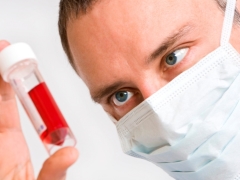The child has elevated white blood cells
The level of leukocytes, determined by clinical analysis of the blood of a child, shows the state of the immune system of children. Its increase, called leukocytosis, helps diagnose various diseases, so parents should know what problems with a child’s health can cause leukocytosis and what to do if a blood test of a daughter or son showed an overestimated number of white blood cells.
What level of white blood cells is considered elevated
Normally, the maximum level of leukocytes is observed in newborns, and then it gradually decreases. The upper limit of the normal rate at different ages is considered:
|
Have a newborn |
30 x 109/ l |
|
From the 5th day of life |
15 x 109/ l |
|
From the 10th day of life |
14 x 109/ l |
|
In infants older than 1 month |
12 x 109/ l |
|
From 1 year |
11 x 109/ l |
|
From the age of 5 |
10 x 109/ l |
|
15 years old |
9 x 109/ l |
If the result on the child’s analysis form exceeds these figures, it is considered a leukocytosis. Such an increase is a reason for additional examination in order to identify the cause of a higher number of white bodies, as well as their ratio, called a leukocyte formula.
Causes of increased white blood cell count
Physiological leukocytosis
A non-dangerous increase in the number of white blood cells is observed:
- After eating.
- After exercise.
- After crying or frightening a nursing baby.
- After emotional overload.
- After a hot bath.
If a child is affected by any of these factors, you do not need to do anything, since the leukocytes will return to normal on their own within a few hours. Their impact is important to consider when blood is taken for general analysis.

Diseases in which leukocytes are elevated
If the blood test was done according to the rules, a rise in white blood cells will indicate a pathological process in the child’s body. The indicator above the norm is typical for such pathologies:
- Purulent infectionsFor example, meningitis, otitis, appendicitis, pyelonephritis, cholecystitis, pneumonia, and others. With abscesses or sepsis, the level of leukocytes increases several times.
- Inflammatory diseases, for example, chronic intestinal inflammation or arthritis.
- Poisoning spoiled food, heavy metals, drugs and other poisons.
- Viral infectionsFor example, bronchitis, ARVI, rubella, hepatitis.
- Allergic diseases.
- Infection with fungi and protozoa.
- Rheumatism.
- Autoimmune diseases.
- Burns
- Injuries.
- Blood lossas well as blood transfusions.
- Oncological diseases.
- Bone marrow affections.
- Splenectomy.
Also, an increased level of leukocytes is detected in children who have had surgery. While the child is recovering, the leukocytes in his blood will be elevated.
Leukocyte changes
Doctors evaluate not only the total number of leukocytes and its increase, but also the ratio of different forms of white blood cells, since leukocytosis indicates an infection, but without an assessment of the leukocyte formula, it is impossible to understand what kind of infection in question. This is emphasized by the popular doctor Komarovsky.
For example, if eosinophils and leukocytes are elevated in a child (this analysis result is called eosinophilia), this will prompt the doctor to look for allergies and examine the baby for the presence of worms. In a situation where monocytes and leukocytes are elevated in a child (this is called monocytosis), mononucleosis must first be excluded.
The predominance of neutrophils, called neutrophilia, is more characteristic of infection by bacteria, and the identification of a greater number of lymphocytes, called lymphocytosis, is more common with viral infections.
The most common causes of increasing the number of individual forms of white blood cells are:
|
Neutrophilia |
Bacterial infections Inflammation of the internal organs Oncopathology Use of immunostimulating drugs Graft Blood loss |
|
Monocytosis |
Leukemia Nonspecific ulcerative colitis Rheumatism Infectious mononucleosis Viral infections Infection with parasites or protozoa Tuberculosis Lymphogranulomatosis |
|
High basophils |
Chickenpox Allergic reaction Hypothyroidism Nephrosis Ulcerative colitis Chronic leukemia Hormonal medication Hodgkin's Disease Anemia caused by hemolysis Splenectomy |
|
Eosinophilia |
Allergic reaction Parasite infestation Scarlet fever Rheumatism Malaria Leukemia Mononucleosis Recovery from bacterial infection |
|
Lymphocytosis |
Viral infections Leukemia Poisoning Use of certain drugs |
Symptoms
When a child's white blood cells are elevated, it often manifests itself:
- Tiredness
- Moderate or high body temperature.
- Increased sweating.
- Loss of appetite
- Vertigo.
- Sleep disturbance
- Impaired vision.
- Sore muscles and joints.
- Weight loss
What to do
If the blood of a child is determined to have leukocytes above the norm, this does not go unnoticed by the doctor and requires a more detailed examination. especially if there are any complaints. By itself, leukocytosis is not a disease, but only acts as one of the signs that the baby’s body has an inflammatory process.
Having determined the cause of leukocytosis, the doctor will focus on treating the underlying disease, for example, a purulent infection or injury. As soon as the child recovers, the level of leukocytes will return to normal for his age indicators.
How to take a blood test so that the indicator is reliable
In order for the number of white blood cells to correspond to the real picture, the child should not eat food before taking the test. If we are talking about babies, then after feeding should be at least 2 hours. From drinks, the child should be given only drinking water, since it does not affect blood counts.
It is also important to eliminate physical exertion and experience.. If the analysis is done in the clinic, the child should go there in advance, giving the baby 10-15 minutes to rest in the corridor. Also, before taking blood, it is necessary to calm the child so that he does not fear manipulation, and this does not affect the level of leukocytes.
More information about the general analysis of blood, see the transfer of Dr. Komarovsky.














